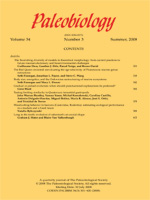The late Neogene was a time of major environmental change in Tropical America. Global cooling and associated oceanographic reorganization and the onset and intensification of glaciation in the Northern Hemisphere during the past ten million years coincided with the uplift of the Central American isthmus and resulting changes in regional oceanographic conditions. Previous analyses of patterns of taxonomic turnover and the shifting abundances of major ecological guilds indicated that the regional shallow-water marine biota responded to these environmental changes through extinction and via a restructuring of local benthic food webs, but it is not clear whether this ecological response had an effect on the diversity of molluscan assemblages in the region. Changes in regional and local diversity are often used as proxies for similar ecological response to environmental change in large-scale paleontological studies, but a clear relationship between diversity and ecological function has rarely been demonstrated in marine systems dominated by mollusks. To explore this relationship, we have compiled a data set of the stratigraphic and environmental distribution of genera of mollusks in large new collections of fossil specimens from the late Neogene and Recent of the southwestern Caribbean. Analysis of a selection of ecological diversity measures indicates that within shelf depths, assemblages from deeper water (51–200 m) were more diverse than shallow-water (<50 m) assemblages in the Pliocene. Lower diversity for shallow-water assemblages is caused by increased dominance of a few superabundant taxa in each assemblage. This implies that studies of diversity of shelf benthos need to control for relatively fine scaled environmental conditions if they are to avoid interpreting artifacts of uneven sampling as true change of diversity. For shallow-water assemblages only, there was significant increase in local and regional diversity of bivalve assemblages after the late Pliocene. No parallel increase in gastropods could be detected, but this likely is because sample size was inadequate for documenting the diversity of gastropod assemblages following a steep post-Pliocene decline of average gastropod abundance. Both the increasing bivalve diversity and the decrease in average abundance of gastropod taxa correspond to an interval of increasing carbonate deposition and reef building in the region, and are likely a result of increased fine-scale habitat heterogeneity controlled by the local distribution of carbonate buildups. Each of these results demonstrates that documenting the ecological response of tropical marine ecosystems to regional environmental change requires a large volume of fine-scaled samples with detailed paleoenvironmental control. Such data sets are rarely available from the fossil record.
How to translate text using browser tools
1 January 2007
Coral reef development drives molluscan diversity increase at local and regional scales in the late Neogene and Quaternary of the southwestern Caribbean
Kenneth G. Johnson,
Jonathan A. Todd,
Jeremy B. C. Jackson
ACCESS THE FULL ARTICLE

Paleobiology
Vol. 33 • No. 1
January 2007
Vol. 33 • No. 1
January 2007




